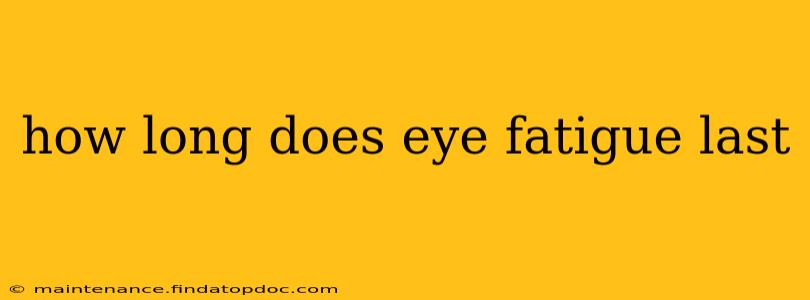Eye fatigue, also known as eye strain, is a common ailment affecting millions. That burning, itchy, or tired feeling in your eyes can be incredibly disruptive, impacting productivity and overall well-being. But how long does this discomfort typically last? The answer, unfortunately, isn't a simple one. The duration of eye fatigue depends on several factors, and understanding these is key to effective management.
What Causes Eye Fatigue?
Before diving into duration, let's explore the root causes. Eye strain often stems from prolonged near-work activities like reading, writing, using computers, or working on smartphones. These activities require sustained focus, leading to overworked eye muscles. Other contributing factors include:
- Poor lighting: Insufficient or harsh lighting strains the eyes.
- Incorrect posture: Slouching while working puts extra strain on the eyes and neck.
- Uncorrected refractive errors: Nearsightedness, farsightedness, or astigmatism, if left uncorrected, significantly contribute to eye fatigue.
- Dry eyes: Lack of sufficient lubrication can lead to discomfort and fatigue.
- Medical conditions: Certain medical conditions can also exacerbate eye strain.
How Long Does Eye Fatigue Typically Last?
The duration of eye fatigue is highly variable. In many cases, mild eye strain resolves within a few hours after resting the eyes and taking breaks. A simple change of activity, a short walk outdoors, or even a few minutes of eye exercises can often provide significant relief.
However, more severe or persistent eye fatigue can last for days, weeks, or even longer, especially if the underlying cause isn't addressed. Chronic eye strain can be a significant problem, often leading to headaches, blurred vision, and neck pain. If your eye fatigue persists beyond a few days, seeking professional help is crucial.
How to Treat Eye Fatigue?
Effective management of eye fatigue involves addressing both the symptoms and the underlying cause. Here are some helpful strategies:
- The 20-20-20 rule: Every 20 minutes, look at an object 20 feet away for 20 seconds. This helps relax the eye muscles.
- Regular breaks: Take frequent breaks from near-work activities. Get up, stretch, and move around.
- Proper lighting: Ensure adequate, well-distributed lighting in your workspace. Avoid glare from screens.
- Correct posture: Maintain good posture to minimize strain on your eyes and neck.
- Eye drops: Artificial tears can help alleviate dryness and discomfort.
- Eye exercises: Certain exercises can help strengthen eye muscles and improve focus. (Consult an ophthalmologist for suitable exercises).
- Address refractive errors: If you suspect uncorrected vision problems, consult an optometrist or ophthalmologist for an eye exam.
What if My Eye Fatigue is Severe or Persistent?
Persistent or severe eye fatigue should not be ignored. It could indicate an underlying medical condition requiring professional attention. Seek immediate medical advice if you experience:
- Sudden vision changes: Blurred vision, double vision, or loss of vision.
- Severe headaches: Persistent or debilitating headaches associated with eye strain.
- Eye pain: Sharp or stabbing pain in or around the eye.
- Redness and swelling: Significant redness or swelling in the eyes.
Does Eye Fatigue Always Go Away?
In most cases, with proper management and addressing the underlying cause, eye fatigue resolves completely. However, if the cause isn't addressed—for instance, if you continue to work long hours at a computer with poor posture and lighting—eye strain can become a chronic problem. Therefore, adopting preventive measures is crucial for long-term eye health.
How Can I Prevent Eye Fatigue?
Prevention is key. By proactively managing your workspace and work habits, you can significantly reduce your risk of developing eye fatigue:
- Maintain good posture: Sit upright with your monitor at eye level.
- Use proper lighting: Avoid glare and ensure adequate illumination.
- Take frequent breaks: Implement the 20-20-20 rule and take regular breaks from near-work activities.
- Adjust your screen settings: Reduce screen brightness and adjust contrast for optimal viewing comfort.
- Use blue light filtering glasses: These glasses can help reduce eye strain associated with digital devices.
By understanding the causes, duration, and treatment options for eye fatigue, you can take proactive steps to protect your eye health and maintain overall well-being. Remember, seeking professional help for persistent or severe eye strain is crucial for a proper diagnosis and effective treatment.
